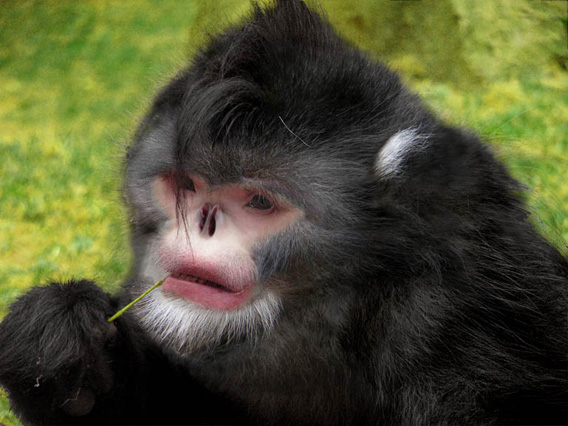
Photo source: Dr. Thomas Geismann; With no photos yet of a living Myanmar snub-nosed monkey, this image was reconstructed using Photoshop based on a Yunnan snub-nosed monkey and the carcass of the newly discovered species, the Myanmar snub-nosed monkey.
International Primate Experts have recently found a new species of snub-nosed or pub-nosed monkeys in the jungles of northern Myanmar. The monkey has been scientifically named Rhinopithecus strykeri, in honor of the president and founder of the Arcus Foundation (an organization that specializes in the conservation and protection of great apes), Jon Stryker. However, its common name is the Myanmar Pug Monkey. This is the first species of snub-nosed monkeys ever to be discovered in Myanmar, with the majority found in China and Vietnam. The monkeys have been known to specifically inhabit the Maw River area and the Kachin state in northeastern Myanmar. This area is in between the Mekong River and the Salween River, two major barriers that may have been the cause for the late discovery of the species.
However, locals are quite familiar and are long aware of the monkeys. They have been calling the monkey mey nwoah (in a local dialect of their area), which translates to “monkey with an upturned face.” No video footage has yet been obtained of the new Snub-nosed monkeys but here is a video of other snub-nosed monkeys, who have a very similar appearance to the new species, in their natural habitat. A physical description of the new species is described as having a full body of dark, blackish fur with the exception of some white fur around the perineal area, the ear tufts, and the chin. Also, the monkeys have extremely long tails, measuring about 140% of their body size. It is said to be the largest snub-nosed monkey discovered, to date.
Despite the fact that this is the only species of snub-nosed monkeys in Myanmar, what really makes the Myanmar Pug Monkey unique is the fact that they sneeze as a result of rain. According to villagers, the monkeys are easy to locate on wet days because they tend to make an extreme amount of noise when it is raining. The monkeys sneeze because rainwater drips into their noses and to evade this happening, they spend hours sitting with their heads tucked in between their knees on rainy days.
It is believed that there is only 260-330 monkeys of this species still living and this number is within the range of the IUCN Red List ( a list that pertains to endangered species). Although his species has only recently been discovered, it has long been facing multiple dangers. Chinese logging companies have been interfering with the monkeys’ area and have been increasing hunting pressure. Some procedures will be taken in order to protect and lengthen the lifespan of the newly found species to ensure that the sneezing Myanmar Pug Monkeys will be around for a long time.
How do the other species of snub-nosed monkeys compare and differ from the Myanmar pug monkey? What are the immediate and ultimate causes of sneezing because of the rain? What kind of behavior is the monkey sneezing as a reaction to the rain? Is this behavior innate or learned? Why?






